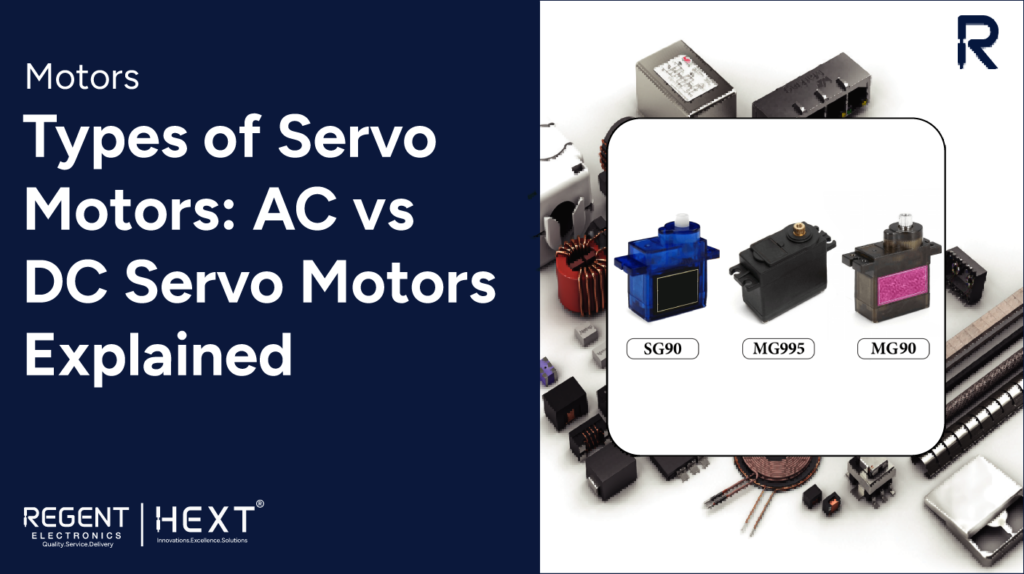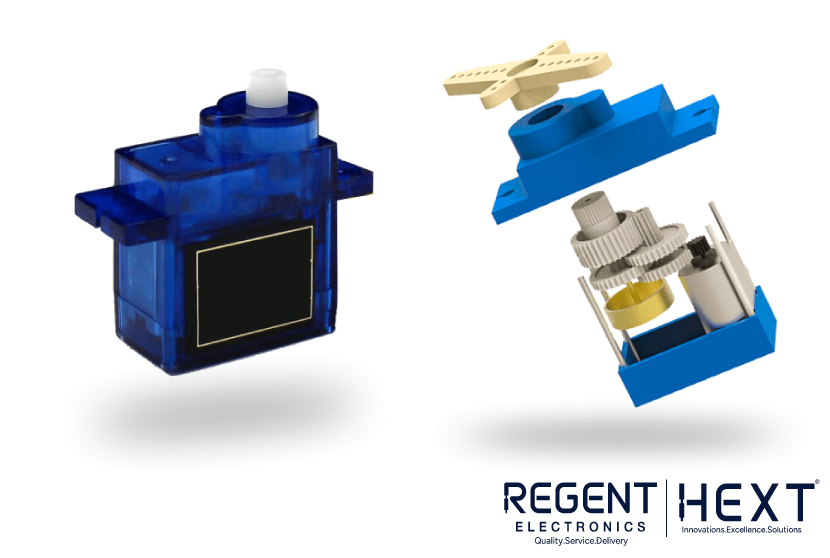
Types of Servo Motors: AC vs DC Servo Motors Explained
Are you curious about the different types of servo motors and where they’re commonly used? Whether you’re building a robotic arm, designing an automated system, or integrating motion control into your project, choosing the right type of servo motor is critical.
In this article, Regent Electronics explores the main types of servo motors — AC and DC — and breaks down their unique characteristics, working principles, and common applications.
⚙️ What is a Servo Motor?
A servo motor is an electromechanical device used to achieve precise control of position, speed, and acceleration in automation systems. It works on a closed-loop mechanism, using a feedback sensor (typically an encoder or potentiometer) to monitor position and make real-time corrections via a controller.
Servo motors can be rotary or linear actuators and are known for their high accuracy, fast response, and efficient torque output. They are widely used in industrial automation, robotics, CNC machinery, aerospace, and even consumer electronics.
🛠️ Types of Servo Motors

Servo motors are generally classified based on the type of electrical supply they use. The two main categories are:
- AC Servo Motors
- DC Servo Motors
Let’s explore both in detail.

1️⃣ AC Servo Motor
An AC servo motor operates using alternating current and typically incorporates an encoder for feedback. These motors are known for their high speed, precise positioning, and robust performance under heavy-duty cycles.

Key Features:
- Integrated encoder for feedback
- Closed-loop control for high accuracy
- Ideal for automation and industrial-grade machinery
Applications:
- Robotics
- CNC machines
- Automated manufacturing
- Packaging equipment
🔄 Types of AC Servo Motors
✅ Positional Rotation Servo Motor
This type rotates within a fixed angle, usually up to 180 degrees. Internal physical stops limit the shaft’s movement to protect the position sensor. These are widely used in:
- RC toys
- Model aircraft
- Robotic joints
✅ Continuous Rotation Servo Motor
Unlike positional servos, these can rotate indefinitely in either direction. The control signal determines rotation direction and speed, not position. Ideal for:
- Radar dishes
- Mobile robots
- Conveyor mechanisms
✅ Linear Servo Motor
This motor translates rotary motion into linear back-and-forth motion using additional gearing. Though less common, they are used in:
- Model aircraft as actuators
- Precision positioning applications
2️⃣ DC Servo Motor

A DC servo motor operates using direct current and offers quick response, simple design, and fine control. These motors can be controlled through either the armature or field current, depending on the application.
Key Benefits:
- Fast and accurate response
- Easier to control using microcontrollers
- Widely used in electronic devices and light-load machinery
Applications:
- Camera autofocus systems
- Remote control vehicles
- Laboratory automation
- CNC tools
⚡ Types of DC Servo Motors
✅ Series Servo Motor
Known for high starting torque, this motor draws substantial current and offers less speed regulation. Useful where torque is prioritized over speed consistency.
✅ Split Series Servo Motor
Functions as an independently energized field-controlled motor. Delivers high stall torque and a steep torque-speed decline, making it suitable for quick directional changes.
✅ Shunt Control Motor
Features two windings — field (on the stator) and armature (on the rotor) — connected in parallel. It offers steady performance and is commonly used in automation systems.
✅ Permanent Magnet Shunt Motor
This motor uses permanent magnets to create the magnetic field, offering performance similar to a shunt motor but with reduced size and complexity. Ideal for compact designs and energy-efficient systems.
🧠 Final Thoughts
Servo motors are essential components in motion control systems, offering high precision, speed, and adaptability. Choosing between an AC or DC servo motor depends on the specific requirements of your project — whether it’s power, precision, speed, or control method.
At Regent Electronics, we provide a wide range of servo motors and controllers to suit projects of all scales — from hobby electronics to full-scale industrial automation.
